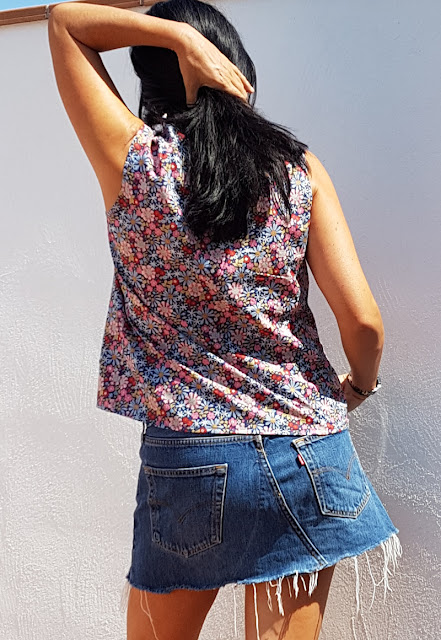This is one of these pieces that make a wardrobe. Lately, I try to pick well my projects, with good patterns and made with noble fabrics, slowly and throughout. This is one of those.
I loved the Mary Quant dress in the cover of this book:

but I did not like the pattern, with a yoke in front to make the bust shaping. I preferred it with princess seams shaping the bust, waist and evasée skirt. Also in the book, we can find the Diana dress:
...with its princess seams. I had to play a little bit around both patterns to mix them properly and add some of the features I wanted the dress to have. These modifications were made first on paper.
Into the Diana four pieces (centre front and back, sides front and back), I made the Mary's armscyes, which had to accommodate the Mary's sleeves, and also the Mary's neck, which round shape I preferred to the boat shape in the Diana's.
I put the modified pattern pieces on the dress form, and it was obvious that they were good on the bust area, but too roomy in the waist, where the Diana dress is not precisely tight. Also, it lacked any flare at the skirt. To be sure about this, I decided to make a toile, modify it and use it as pattern (and for safe-keeping). But if we make sure that the pattern is big enough (and we are in a hurry, as it was the case), we can make the alterations in the real fabric.
I decided to leave the front and back central pieces intact and shape the waist in the side pieces.
 |
| After "all day at school", with Christmas lunch included. |
I had first to remove all the 1.6cm around every pattern piece, because I do not work with included seam allowances, of course!
So, I took 2 cm off the waist in the side pieces, and added 3 cm of flare in all of them, starting at the hip area and progressing evenly from there.
I tailor-tacked all the pieces to mark them properly, put the back invisible zipper to start with, and basted all the pieces together to the first real fitting on me. The reason I do not like making toiles, is that they do not have the weight and hand of the real fabric. Only with the real fabric we can decide if it is too tight, etc. That first fitting was a total success, the gorgeous wool crepe I had bought at Stone Fabrics was hanging beautifully on me, so I started to machine stitch it all.
I finished the seam allowances with a machine zig-zag all around, and pressed them open. I had not stay-stitched the curves of the princess lines at the bust and that was a mistake, as some of them gave under the press, but I could reshape them on the dress form.
Then I proceeded with the sleeves, for which I had bought this wonderful silk chiffon in Stone Fabrics as well. First, I marked them with tailor tucks, gathered the caps and cuffs' parts, and put the cuffs on, with buttonholes made. I closed the sleeves with French seams, and basted them to the dress. I machine-stitched the underarm part, but hand-stitched the caps, to better absorb the gathers. No machine needle I had was up to the task of sewing chiffon, and it pulled some threads here and there, that I managed to recuperate pulling them back into place.
I self encased the armscyes' hem allowances into themselves, basting them first and hand-sewing them with am inconspicuous slip stitch.
I finished the bottom hem by hand too, no top-stitching for this classic jewel of a dress.
The result is just gorgeous, I love it. It is classic, elegant, comfortable to wear and becoming to my no-waist figure.
I'll keep the modified pattern to replicate it again, I've been wanting a good princess-seamed dress for ages.




















































